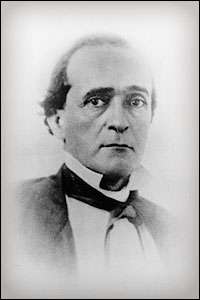Harris Flanagin
Harris Flanagin (November 3, 1817 – October 23, 1874) was an American politician who served as the 7th governor of Arkansas from 1862 to 1864. Prior to this he served as an officer of the Confederate States Army who commanded an Arkansas mounted rifle regiment in the Western Theater of the American Civil War.[1]
Harris Flanagin | |
|---|---|
 | |
| 7th Governor of Arkansas | |
| In office November 15, 1862 – April 18, 1864 In exile April 18, 1864 – May 26, 1865 | |
| Preceded by | Thomas Fletcher (acting) |
| Succeeded by | Isaac Murphy |
| Member of the Arkansas House of Representatives from Clark County | |
| In office November 7, 1842 – November 4, 1844 Serving with J. D. Stewart | |
| Personal details | |
| Born | November 3, 1817 Roadstown, New Jersey, U.S. |
| Died | October 23, 1874 (aged 56) Arkadelphia, Arkansas, U.S. |
| Resting place | Rose Hill Cemetery, Arkadelphia, Arkansas, U.S. 34°7′8.3″N 93°3′42.6″W |
| Political party | Whig, Democratic |
| Spouse(s) | Martha Eliza Nash (m. 1851) |
| Children | 3 |
| Military service | |
| Allegiance | |
| Branch/service | |
| Years of service | 1861–1862 |
| Rank | |
| Commands | 2d Arkansas Mounted Rifles |
| Battles/wars | American Civil War |
Early life and education
Harris Flanagin was born in Roadstown, New Jersey, to James, an undertaker and furniture dealer, and Mary (née Harris) Flanagin. He received a fairly good education in a Quaker school of New Jersey and then went to teach at Clermont Seminary, near Frankford (present-day Philadelphia), Pennsylvania. Soon after this he moved to Illinois where he again tried teaching and while at this work studied law.[2] In 1837 he moved to Arkansas and operated a law office in Greenville, the county seat of Clark County, but later moved to Arkadelphia, the new county seat. He served in the Arkansas House of Representatives from 1842 to 1844. He was married on July 3, 1851, to Martha Eliza Nash.[3]
American Civil War
During the American Civil War, Flanagin served in the Confederate States Army as a captain and rose to the rank of colonel before the conflict was over. He served with the 2d Arkansas Mounted Rifles.[4] In 1862, he was elected Governor of Arkansas and was recalled from active duty to take office.[5] His administration dealt primarily with war related measures and maintaining order and continuing government while undergoing an invasion. His administration was faced with shortages of critical items, rising prices, care of fallen soldier's families, and related problems. During the war the government was forced to suspend the collection of taxes and financed the war with paper "war bonds".[3] When on September 10, 1863, Little Rock fell to United States forces, and Arkansas’s government fled the city, he seized as many government documents as he could and reestablished the capitol at Washington, Arkansas. While he remained in Confederate controlled territory, a new Union government under Isaac Murphy was inaugurated on April 18, 1864.
Later life
After the American Civil War, Flanagin returned the state archives and resumed his law practice in Arkadelphia. He is buried at Rose Hill Cemetery, Arkadelphia.[6]
References
- Evans, Clement A., ed. (1899). Confederate Military History. Vol. I. Atlanta, Ga.: Confederate Pub. Co. p. 718. LCCN 02017198. OCLC 951143. OL 7023000M – via Internet Archive.
- "Harris Flanagin". National Governors Association. Retrieved March 29, 2020.
- Newberry, Farrar. "Harris Flanagin." Arkansas Historical Quarterly 17 (Spring 1955): 3–20.
- Evans, Clement A., ed. (1899). Confederate Military History. Vol. X. Atlanta, Ga.: Confederate Pub. Co. p. 285. LCCN 02017198 – via Internet Archive.
- Yearns, W. Buck, ed. (1985). The Confederate Governors. Athens: University of Georgia Press. ISBN 082030719X. LCCN 84000154. OL 2838407M – via Internet Archive.
- Dougan, Michael B. (April 25, 2018). "Harris Flanagin (1817–1874)". Encyclopedia of Arkansas. Central Arkansas Library System.
External links
| Wikimedia Commons has media related to Harris Flanagin. |
- Harris Flanagin at Find a Grave
- Harris Flanagin at The Political Graveyard
- Works by or about Harris Flanagin at Internet Archive
- Works by or about Harris Flanagin in libraries (WorldCat catalog)
